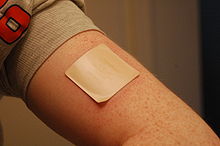User:Mr. Ibrahem/Nicotine replacement therapy
 A nicotine patch is applied to the left arm | |
| Clinical data | |
|---|---|
| Trade names | Nicoderm, Commit, Nicorette, Nicotrol, others[1] |
| AHFS/Drugs.com | Monograph |
| MedlinePlus | a601084 |
| License data | |
| Identifiers | |
| |
Nicotine replacement therapy (NRT) is a medically-approved way to take nicotine by means other than tobacco.[3] It is used to help with quitting smoking or stopping chewing tobacco.[1][4] It increases the chance of quitting smoking by about 55%.[5] Often it is used along with other behavioral techniques.[1] NRT has also been used to treat ulcerative colitis.[1] Types of NRT include the adhesive patch, chewing gum, lozenges, nose spray, and inhaler.[1] The use of multiple types of NRT at a time may increase effectiveness.[6][7]
Common side effects depend on the formulation of nicotine.[1] Common side effects with the gum include nausea, hiccups, and irritation of the mouth.[1] Common side effects with the patch include skin irritation and a dry mouth while the inhaler commonly results in a cough, runny nose, or headaches.[1] Serious risks include nicotine poisoning and continued addiction.[1] They do not appear to increase the risk of heart attacks.[5] There are possible harms to the baby if used during pregnancy.[1][8] Nicotine replacement therapy works by reducing cravings caused by nicotine addiction.[1][9]
They were first approved for use in 1984, in the United States.[1] Nicotine replacement products are on the World Health Organization's List of Essential Medicines.[10][11] They are available as generic medication.[1] In the United States a month of patches or gum is between US$100 and US$200 while the other forms are more expensive.[12]
References[edit]
- ^ a b c d e f g h i j k l m n "Nicotine". The American Society of Health-System Pharmacists. Archived from the original on 18 December 2015.
- ^ "WHOCC - ATC/DDD Index". www.whocc.no. Retrieved 22 September 2020.
- ^ Jain R, Majumder P, Gupta T (2013). "Pharmacological intervention of nicotine dependence". BioMed Research International. 2013: 278392. doi:10.1155/2013/278392. PMC 3891736. PMID 24490153.
{{cite journal}}: CS1 maint: unflagged free DOI (link) - ^ Smith KD, Scott MA, Ketterman E, Smith PO (April 2005). "Clinical inquiries. What interventions can help patients stop using chewing tobacco?". The Journal of Family Practice. 54 (4): 368–9. PMID 15833231.
- ^ a b Hartmann-Boyce J, Chepkin SC, Ye W, Bullen C, Lancaster T (May 2018). Cochrane Tobacco Addiction Group (ed.). "Nicotine replacement therapy versus control for smoking cessation". The Cochrane Database of Systematic Reviews. 5: CD000146. doi:10.1002/14651858.CD000146.pub5. PMC 6353172. PMID 29852054.
- ^ McDonough M (August 2015). "Update on medicines for smoking cessation". Australian Prescriber. 38 (4): 106–11. doi:10.18773/austprescr.2015.038. PMC 4653977. PMID 26648633.
Evidence suggests that combinations of nicotine replacement therapy may be more effective than using a single formulation
- ^ Cahill K, Stevens S, Perera R, Lancaster T (May 2013). "Pharmacological interventions for smoking cessation: an overview and network meta-analysis". The Cochrane Database of Systematic Reviews. 5 (5): CD009329. doi:10.1002/14651858.CD009329.pub2. PMID 23728690.
Combination NRT also outperformed single formulations
- ^ De Long NE, Barra NG, Hardy DB, Holloway AC (December 2014). "Is it safe to use smoking cessation therapeutics during pregnancy?". Expert Opinion on Drug Safety. 13 (12): 1721–31. doi:10.1517/14740338.2014.973846. PMID 25330815.
- ^ "Nicotine Replacement Therapy for Smoking Cessation or Reduction: A Review of the Clinical Evidence". Canadian Agency for Drugs and Technologies in Health. 16 January 2014. PMID 24741730.
{{cite journal}}: Cite journal requires|journal=(help) - ^ World Health Organization (2019). World Health Organization model list of essential medicines: 21st list 2019. Geneva: World Health Organization. hdl:10665/325771. WHO/MVP/EMP/IAU/2019.06. License: CC BY-NC-SA 3.0 IGO.
- ^ "Nicotine Replacement Therapy (NRT) (Inclusion)". World Health Organization. 11 December 2010. Retrieved 28 May 2020.
- ^ Hamilton, Richart (2015). Tarascon Pocket Pharmacopoeia 2015 Deluxe Lab-Coat Edition. Jones & Bartlett Learning. p. 441. ISBN 9781284057560.
